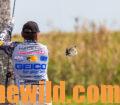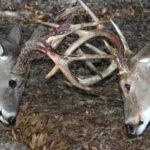Editor’s Note: Most fishermen will name May and June as the main months for catching big bream, which includes bluegills and shellcrackers, and particularly the time around the full moon in May. The bluegill has a black dot on the back part of its dorsal fin with blue cheeks and gill covers. Bluegills primarily eat water insects, inhabit rivers, swamps, ponds and reservoirs and provide fodder for bass. Shellcrackers (also called Redear sunfish) generally grow larger than bluegills and eat snails, small mussels, worms, crickets and bugs with a world’s record of 5 pounds, 7 ounces caught in South Carolina. But, to catch either shellcrackers or bluegills that weigh almost 5 pounds, certain conditions have to come together to produce a new world-record. Just like you can’t take a trophy whitetail, if a trophy whitetail doesn’t live on the property you hunt, the same is true for catching monster-sized bream. Here are some of the ingredients that must come together to produce huge bluegills – a 1-1/2 to 2 pounder.
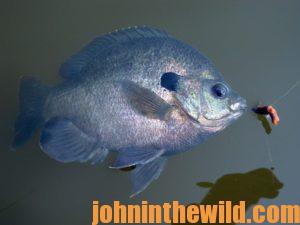 One of the largest bluegills ever caught was a 4-pound 12-ounce monster taken almost 70-years ago in 1950 out of Ketona Lake near Birmingham, Alabama. In 1947, Coke McKenzie of Birmingham caught a 4-pound, 10-ounce bluegill at Ketona Lake that was 15-1/4-inches long and 8-inches wide. The previous world record at that time was only 2 pounds, 8 ounces. Three weeks later a 3-1/2-pound bluegill also was taken from the same lake. And, before the year was out, a 2-pound 8-ounce bream was boated there. Then, in 1950, T.S. Hudson, also of Birmingham, caught a new world-record bream from Ketona that tipped the scales at 4 pounds, 12 ounces.
One of the largest bluegills ever caught was a 4-pound 12-ounce monster taken almost 70-years ago in 1950 out of Ketona Lake near Birmingham, Alabama. In 1947, Coke McKenzie of Birmingham caught a 4-pound, 10-ounce bluegill at Ketona Lake that was 15-1/4-inches long and 8-inches wide. The previous world record at that time was only 2 pounds, 8 ounces. Three weeks later a 3-1/2-pound bluegill also was taken from the same lake. And, before the year was out, a 2-pound 8-ounce bream was boated there. Then, in 1950, T.S. Hudson, also of Birmingham, caught a new world-record bream from Ketona that tipped the scales at 4 pounds, 12 ounces.
What was the magic formula that produced these buster bream? Can these conditions be produced somewhere else? The answer is a very-definite, “Yes.” Lake Ketona, home of two world’s record bluegills was a deep, clear limestone quarry that had a small spawning area around the ledges of the deep quarry. Too, the bass population in this now-closed lake was high, which meant the bass kept the bluegill population low, and the bluegills increased in size with more food.
During the spring and summer, most anyone can catch bream, which will be around piers, under willow trees and in most shallow water. In the more-rocky terrains, they will be in little pools and shady spots on the side of the rocks and boulders and under the rocks waiting on the bait to pass by. These will be the average to small bream – the bream that anyone can catch, and that most breamers do catch. But according to fisheries biologists, to catch trophy bluegills, the best place to start is to fish a heavily-fertilized farm pond with a crowded bass population. As one of my fisheries biologist friends explains, “If a lake or a pond has low numbers of bream, then those bream have more food available and can grow to a larger size. By increasing the number of prey fish in a body of water, you insure that only a small number of bream offspring will survive, thereby providing more food for the adult bream. Consequently the waters will home fewer bream – but they will be bigger.”
* Camouflage the Hook and Hide and Wait to Catch Clear-Water Bream: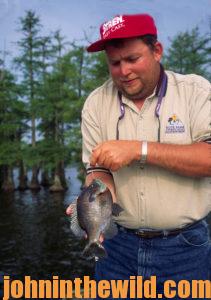
The subtle mistakes that most bream anglers make are the mistakes that the big bream key in on and avoid. For instance, oftentimes, large, smart bream can spot hooks in baits. So, bury or camouflage the hook as much as possible in the bait. Big bream are extremely wary, and Lake Ketona was crystal clear. So, the men who took the records had to overcome the fish’s ability to see them. Using light line, no weights and a glob of worms that completely hid their hooks, these big bream anglers hid on the bank. The men cast out their baits, and as the worms gently floated-down to the bottom, the anglers watched for twitches on their lines to signify strikes. This hide-and-wait tactic worked twice for world-record bream fishermen. This same system also catches bedding bluegills in clear farm ponds with no trees or vegetation around the bank. I have friends who enjoy fishing for the big bream at Merritt’s Mill Pond in northwest Florida near Marianna. Those bream are often caught on very-light line, while fishing at night, so that the bream can’t see the anglers overhead.
* Hunt Bream in Out-of-the-Way Places:
Very-few breamers will drag an aluminum boat 50-yards over a muddy bank to get into an oxbow slough to fish for bream. But, that’s the reason Gayland Gilliken of south Alabama who’s known in that region as the “Bream Man,” can and does catch so-many big bream every year. According to Gilliken, “To catch big bream, you have to get to the fish that no one else can find, like those in the swampy waters where I fish in the Delta section of south Alabama. These bream haven’t been picked-over, and they usually will be more-aggressive than the bream you’ll find in big river systems.”
* Search for Bream in Brackish Water with Seed Shrimp:
Also many bull bream live in brackish water along the bays, rivers and channels that feed into salt water. Although the little brackish-water bream are easy to catch, the big bream often can be very difficult to take. According to my late friend and avid bream fisherman on the Gulf Coast, Les Maske of Magnolia Springs, Ala., “You have to use seed shrimp – those tiny little shrimp that you see up in the eel grass at the mouths of rivers, coves and sloughs in brackish water. Most of the time, those little-bitty shrimp won’t be more than 1/4-inch long. You must use fine hair hooks to hook the seed shrimp through the tail or the horn. The weight of the hook usually will carry the bait down to where the big bream lurk. The big bream are accustomed to eating the small seed shrimp. Oftentimes when they shy-away from worms and crickets, they’ll latch onto the seed shrimp. If I’m fishing a spot that I know other anglers have been fishing heavily, like a boathouse, a pier or a well-known bream bed, I’ll use a really-light, limber fiberglass pole with no lead, no cork and 2-pound-test line. I’ll throw the bait out over my head to the area I want to fish. Then, I’ll let the line sink naturally. When that bream sees that small grass shrimp swimming down, naturally the fish will attack.”
* Use the Birddog Method:
Many old timers use a birddog method when they swear they can smell bream beds. Big schools of bedding bream will give-off a strong, fishy smell, somewhat like overripe watermelons. A good angler can locate a bed like a quality birddog finds his quail. The hunt-and-peck method often will find bream beds that other tactics will not. Small spinners like Zero Mepps
(https://www.mepps.com/), Panther Martins (https://www.panthermartin.com) and Beetle Spins
(https://www.johnsonfishing.com/) are deadly on bream. Cast to the bank, and work those lures close to the bottom. You may pinpoint deep bream beds that other 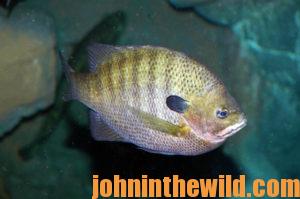 anglers often miss.
anglers often miss.
* Find Bream in the Middles of Sloughs and Lakes:
While I was in school at the University of West Alabama in Livingston, Ala., I hunted and fished at least 4 days a week at my family’s nearby hunting club before and after school and work. By hunting and pecking, I once found a tremendous-sized bluegill bed, 25-yards from the bank that extended to the middle of a slough, off the main river channel on our property. The fish were in 10 feet of water, and I was convinced that this was a virgin bed. For many years, I successfully fished this honey hole. When other boats came into the slough, I put down my ultralight rod and cane pole and began to cast for bass. Bream are supposed to be on the bank. So, no one ever suspected what I was doing in the middle of that slough.
Another good example of successful hunt-and-peck breaming was when I fished at St. Vincent’s Island near Apalachicola, Florida. Guides from various places in Apalachicola had been taking anglers over to the island for years, fishing the same beds for big bluegills and shellcrackers. But, when my brother, Archie went down, he began casting his white Beetle Spin with a red dot on its stomach into the middle of the lake. Soon, he started hauling in buster-sized bluegills. He had discovered a bed in the middle of the lake that had been missed by the guides and anglers for years. Personally, I’m convinced that the hunt-and-peck technique may be the best tactic for locating new, better, bigger bream beds.
* Learn How to Fish a Bream Bed:
Most anglers face a problem with big-bream fishing. What do you do when the bream stop biting? In the spring of the year when bream are bedding, a good fisherman often can limit-out on one bream bed, if he knows about the bedding habits of bream and how to work with the fish. Bream usually bed in a half circle from the bank, while others will be further-out in the water. The temptation for most anglers is to try for the fish they can see close to the bank. However, this error may cost them their limit. A hooked bream usually will run for deep water. If a bluegill is hooked close to the shore, the fish will run-through several-other beds before it reaches deep water. When that happens, the fish on those beds are spooked and leave. After this process is repeated several times, most of the bedding bream will have left an area. Then you’ll only have an opportunity to take a few bank bream from that large bed.
To solve this problem of spooking the bedding fish, work with the bream and not against them. When you locate a bream bed, start casting in front of the fish you can see hoping to catch the bream bedding on the outside edge of the school. Then, when a fish is hooked and runs to deep water, it won’t disturb the other bedding 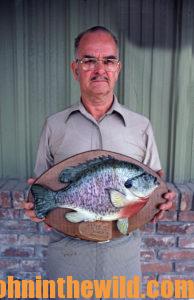 bream. As you catch the outside fish, gradually work your way into the bank bream. This pick-off method will help you to systematically work a bream bed, taking more fish with less running. Besides the pick-off method, another key to catching trophy bream is to have more than one bed spotted. When the action on the bream bed stops, move to another. If the second bed fails to produce, return to the first. Back-and-forth bed-banging can lead to your landing limits of bream.
bream. As you catch the outside fish, gradually work your way into the bank bream. This pick-off method will help you to systematically work a bream bed, taking more fish with less running. Besides the pick-off method, another key to catching trophy bream is to have more than one bed spotted. When the action on the bream bed stops, move to another. If the second bed fails to produce, return to the first. Back-and-forth bed-banging can lead to your landing limits of bream.
* Mop the Bottom:
Although many outdoorsmen seem to think bream die after the warm rays of the summer sun hide from the biting winds of the winter weather, bream can be taken in the wintertime. Often, cold-water bluegills are harder to find, but mopping the bottom gets results. By dragging red worms across the bottom of a pond, a river or a creek that you know contains big bream, you can have pole-bending bluegill action all winter long.
* Fish a Small Beetle Spin, a Keystone Jig and a Tiny Ned Rig:
My fishing buddy David Tucker uses two techniques to catch big bluegills in public ponds and lakes. “Anytime I go to a new lake, I’ll fish well away from the bank, cast toward the bank and reel my Beetle Spin jig in just off the bottom. If I catch a big bluegill in that area, I’ll fan-cast all the way around that whole section of the lake to locate the school.” Tucker also has discovered that the Keystone jig (https://www.facebook.com/renokylures/) will produce trophy bluegills in many lakes. When he arrives at a lake, he studies the shallow water for small minnows along the edge in the weeds or grass. He selects the Keystone jig to fish instead of the Beetle Spin jig, if he sees small minnows swimming near the shore.
“Bluegills prefer to feed on small minnows,” Tucker explains. “The Keystone jig closely resembles a small minnow. By fishing the Keystone jig close to the bottom in the deep water, I can catch big bluegills.” If bluegills don’t readily take the jigs, Tucker will employ his slip-cork, deep-water technique. Holding his boat well away from the site where he thinks the bluegills hold, Tucker will make a long cast using a heavy wooden cork to keep from spooking the fish and to enable his line to fall from the cork to the depths he wants to fish.
“I use the wooden cork to provide the weight I need to make a long cast,” Tucker advises. “I use as little lead as possible, 8 to 10 inches up the line, to allow the live red worms to sink to the bottom. I occasionally move the worms along the bottom, but the cork still will lay flat on the surface of the water. My cork doesn’t suspend my bait up off the bottom but merely acts as a strike indicator. “When the bluegills don’t want to bite, I stay well away from them and make long casts to mop the bottom with live red worms. This technique will produce both bluegills and shellcrackers when jigs won’t. A new lure that catches bream too is a tiny Z-Man Ned Rig
(https://zmanfishing.com/cms/nedrig).”
 To learn more about cooking bream, check out John E. Phillips’ “The Best Wild Game & Seafood Cookbook Ever: 350 Southern Recipes” at http://amzn.to/WkbLRg.
To learn more about cooking bream, check out John E. Phillips’ “The Best Wild Game & Seafood Cookbook Ever: 350 Southern Recipes” at http://amzn.to/WkbLRg.
Tomorrow: What Other Baits and Tactics Catch Big Bream

